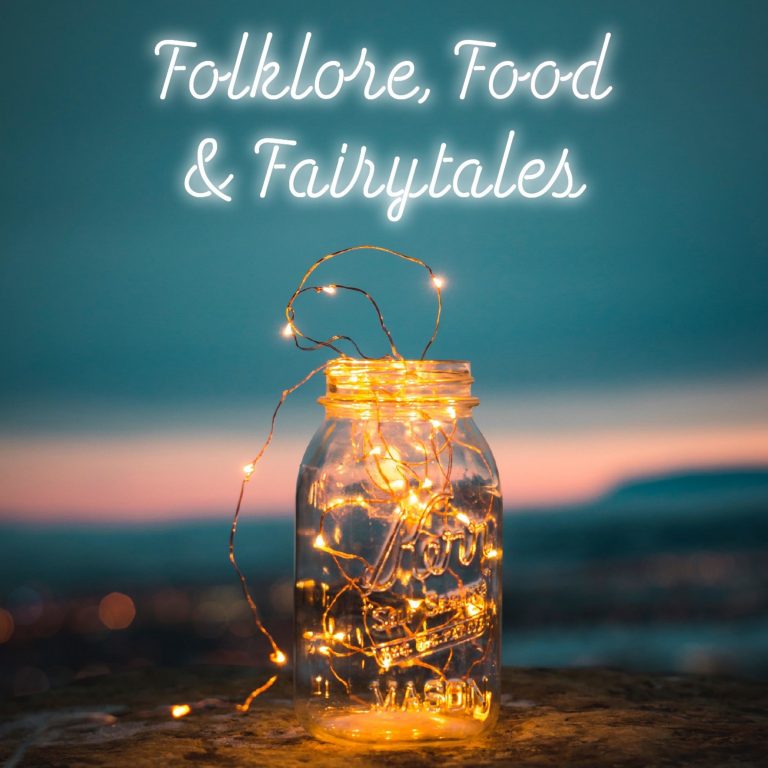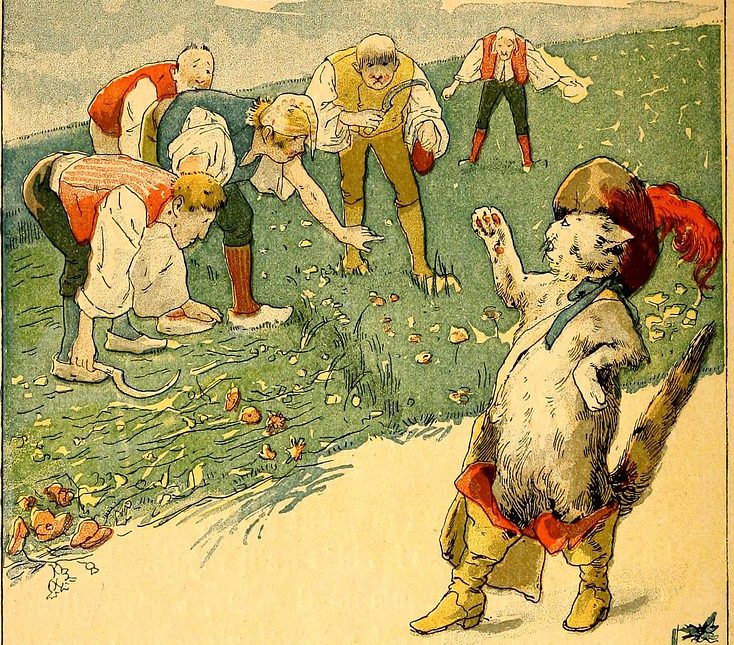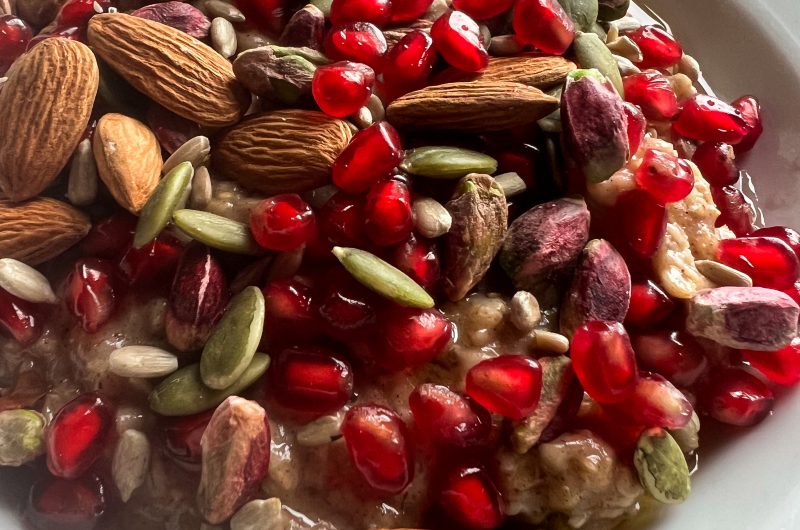In which we discover that if there is ever a choice between a cat and a cow, choose the cat, arguments over porridge are rarely worth it and that the main differences between royalty and commoners is that commoners get a better night sleep and worse dresses.
In which we discover that if there is ever a choice between a cat and a cow, choose the cat, arguments over porridge are rarely worth it and that the main differences between royalty and commoners is that commoners get a better night sleep and worse dresses.
The Story in this episode is: The Palace That Stood on Golden Pillars adaped from Yule-tide stories: a collection of Scandinavian and North German popular tales and traditions from the Swedish, Danish and German
The Recipe in this episode is: Spiced, Jewelled Porridge
If you would like to hear more about what I talked about in this episode you can find books and links at Further Reading
You can find the interviews in my newest interview series here: How Food Frames Stories. You can find my interviews with storytellers here: Vernacular Voices of the Storyteller
You can also subscribe (or just read) my free newsletter for further snippets of folklore, history, stories, vintage recipes, herblore & the occasional cocktail.
You can also find out more at Hestia’s Kitchen which has all past episodes and the connected recipes on the blog. If you’d like to get in touch about the podcast you can find me on Twitter or Instagram at @FairyTalesFood.

So what did you think? Did you enjoy it? I found this translation of this wonderful Swedish story in Yule-tide stories: a collection of Scandinavian and North German popular tales and traditions from the Swedish, Danish and German and I loved it for so many reasons. It’s name in Swedish is Slottet, som stod på Guld-Stolpar.
Puss in Boots but Better
I loved that this version of Puss in Boots helped a poor girl rather than a poor boy. I loved how it was a mash up of The Princess and the Pea and Puss in Boots with a particularly snobbish mother-in-law. Its folktale type ATU 545B and I still smile whenever I think of the town Kattenburg.
I’m glad there is a version of the Princess and the Pea that existed before Hans Christian Andersen as I’m not his greatest fan. I’m also pleased in a way that this princess is only sensitive to the pea because the cat spies for her and tells her it’s there. I also like the ending where no-one has to have their head chopped off to become a prince/princess at the end. I also enjoyed the fact that the prince fell in love with the farm girl even with her non-Royal manners and also that she managed to fool her mother-in-law.
Porridge Based Arguments
One of my absolute favourite things though was the beginning of the story with the strange parents and their cauldron of porridge and their angry row about who had the right to the scrapings of the porridge pot. It could even be a short tale in its own right but it really adds something to this wonderful mixed up story.
There is a surprising amount of folklore about oats and porridge actually. I was intrigued by how many stories feature porridge, in particular the tale of the little porridge pot with the magic words to start and stop the porridge production. One day the girl who was given it goes away for a day and the villagers end up digging themselves out by only by eating the porridge. It also provides a supporting role in Goldilocks.
Scandinavian Violent Elves
I haven’t even started on the Scandinavian house/barn elf. Known as the Nisse in Norway and Denmark, Tomte in Swedish and Tontuu in Finnish. These small yet powerful creatures who protected farms were quite scary originally and did not like to be slighted or teased. There are stories of them simply murdering farmhands who laughed at them. They were rewarded for their service to the farm at Christmas with a special rice porridge and Christmas beer (this differs slightly by location).
The rice porridge also contained a big lump of butter and one story tells of a maid who put the butter at the bottom. The Nisse did not know and felt slighted and killed the farmer’s best cow. When he found butter at the bottom of the bowl he was contrite and went to the next farm and stole their best cow to replace it.
Christmas Takeover
As time went on there was less and less need for a guardian spirit for the farm and so these spirits became friendlier and started to take over some of the nicer Christmas functions. Less murdering, more presents as well as cleaner clothes. They kept their red hats though.
The people of the Nordic countries also eat the special Christmas version of rice porridge but they put on solitary almond in the bowl. In Iceland, Denmark, The Faroe Islands and Norway you get a present from the Yule Lads and in Finland and Sweden, receiving the almond in your portion means you will have luck through the year.
It’s not just in the Nordic countries that there is porridge or oat folklore. In Scotland if you stir the porridge widdershins you can expect the Devil to come to your door for his portion. It is also said that dreaming of oats is an omen of success and that spotting a drop of rain on an oathead means a good harvest to come. A woman could also encourage a girl child over a boy child by wearing a garter made of oat straw. There is also a wart charm using oat straws which would be woven and placed under a rock. As the stems rotted so would the warts fall off.
Bog Bodies
Oats have a long history too particularly in the form of porridge, and there is evidence of people eating them 32,000 years ago. . There are also bog bodies (historic bodies preserved in peat bogs) which are thousands of years old whose stomach contents contained oats and milk in the form of porridge. They were grown by the Romans as animal feed and grown in the Scandinavian countries because they were so much more resistant to the cold and wet than wheat.
This was also true of Scotland although they crossed over much later but had become a staple food for the working classes by the medieval period. It wasn’t just what we would consider porridge today but also gruel (a thinner version of porridge), sowans (a thick drink made from fermented oats) and hasty pudding (a thicker, sweeter porridge that doubled up as dessert) featured prominently in Scotland’s diet for the next 1,000 years.
Animal Feed
They were however looked down upon by the English as a human food (although they were very happy to use them in malt for making beer). Samuel Johnson’s 1775 dictionary entry for oats was: “A grain, which in England is generally given to horses, but in Scotland supports the people.” (On which Lord Elibank commented, “Yes, and where else will you see such horses and such men?”)
The OED has the word first used as 1643 for porridge as the breakfast dish we know it as, but it was definitely made before that and the word comes from pottage which was not just boiled up cereals but may have included meat and almost always vegetables. Pottage is a much older word and in Scotland and I believe Wales too, porridge was allowed to set solid and was then taken by working men to be eaten in slices. The slices could also be fried. The only things found in Scottish porridge were oats, water and salt. Occasionally honey was used to sweeten it for children. Now in England at least some or all of the water is often swapped for milk and sugar and honey are added and often fresh or dried fruit.
Porridges from Around the World
We obviously don’t know what type of porridge was being eaten in our story but as it is a Swedish one it is likely to be rye, barley or oats or a mixture of any of these and was probably sweetened if possible but it may have been a savoury dish closer to pottage. I have only really looked at a Northern Eurocentric examples of porridge here. Porridges are eaten all around the world, consider Congee (rice porridge), Pounded Yam, Fufu, spiced Ethiopian Genfo or even Polenta. The definition is essentially any grain or other vegetable part boiled to a mush. I am personally a huge fan of pounded yam with rich West African soups/stews and I really want to explore this cuisine further, luckily there are more sources of African food becoming available so I can learn more. Porridge also featured as a beneficial dish by practitioners of Buddhism in India.
Essentially the ability of cereals to be crushed into a thick paste which is full of nutrients could be considered to be the spark of our still continuing population explosion as it allowed young children to stop breastfeeding earlier. This allowed their mothers to conceive more often and increased the ability of women to bear more children in the fertile periods of their lives.
Porridge Indulgence
I love porridge but I do tend to gravitate towards more indulgent versions because they still feel comforting and as though they are doing you good. I will always remember reading a Lorna Hill Sadlers Wells book and desperately wanting to have porridge in the same way with soft brown sugar sprinkled over and then rich cream poured over. I usually settle for some nice honey drizzled over and a splash of milk. It’s also easy and fairly quick to cook. Its’ even quicker if you leave the oats soaking in the liquid over night before as it almost halves the cooking time. Something to remember in these days of high energy bills.
I’ve decided to share with you my spiced, jewelled version which is best for weekend mornings but it can easily be scaled back to something a little humbler but still delicious. This has the basic porridge ingredients of oats, milk and water but has added cinnamon and cardamon. I stir in dried fruit, whatever I have to hand, before serving and then once it is in its bowl I heap on pomegranate seeds looking like tiny rubies, green nubbly pistachio nuts, jumbo almonds and pumpkin seeds big and small. Its a wonderful treat that gleams in the autumn gloom.
Spiced, Jewelled Porridge
1
servings2
minutes6
minutesIngredients
- Porridge
40g porridge oats
120ml water
60ml milk
Pinch of salt
1/2 tsp cinnamon
1/2 tsp cardamon
Small handful of dried fruit (whatever you like/have/want to use up)
- Toppings
These are my favourites, consider them a suggestion to build on
Pomegranate seeds
Pistachios
Almonds
Sunflower seeds
Honey (full flavoured) for drizzling
Directions
- If you can remember put the milk/water and oats in a container the night before and pop in the fridge.
- Next day, add to saucepan over medium heat with spices and stir gently preventing mixture from sticking until it thickens into something resembling porridge (2-3 minutes if presoaked or 5-6 if not) and remove from heat and add dried fruit.
- Put in your bowl.
- Drizzle over your preferred amount of honey and then put on fruits nuts and seeds.
- This is still so good without any of the toppings except honey. I think the honey and sees make it feel like a treat without costing an absolute fortune.
Further Reading
A Taste of History – 10,000 years of food in history
An Investigation of the wider Landscape Archaeology of Bog Godies: A Case Study of Lindow II and Tollund Man – Zena Marie Zein Elabdin
Dictionary of Plant Lore – DC Watts
Yule-tide stories: a collection of Scandinavian and North German popular tales and traditions from the Swedish, Danish and German


